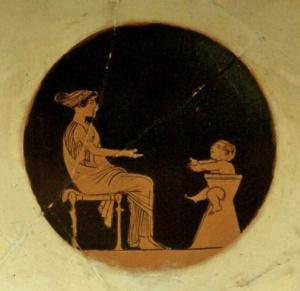Difference between revisions of "Language/Ancient-greek-to-1453/Culture/Amphidromia-Ceremony-birth-of-a-child"
| Line 1: | Line 1: | ||
[[File:red-figure-kylix-brussels_wl.jpg|thumb]] | [[File:red-figure-kylix-brussels_wl.jpg|thumb]] | ||
<div style="font-size:300%;"> Amphidromia : ceremony in honor of the birth of a child</div> | <div style="font-size:300%;">Amphidromia : ceremony in honor of the birth of a child</div> | ||
__TOC__ | |||
This lesson considers the different rites known to have occurred within the oikos and superstitions associated with the oikos. It begins with the rituals which focus upon the hearth of a household and continues with others which take place in the home, though not necessarily at the hearthside. A discussion of the ancient Greek conception of ritual pollution, or miasma, which is often directly linked with several household rites and Ilithyie (in ancient Greek Εἰλείθυια / Eileíthuia) the goddess of Childbirth. She corresponds to Lucine in Roman mythology. | This lesson considers the different rites known to have occurred within the oikos and superstitions associated with the oikos. It begins with the rituals which focus upon the hearth of a household and continues with others which take place in the home, though not necessarily at the hearthside. A discussion of the ancient Greek conception of ritual pollution, or miasma, which is often directly linked with several household rites and Ilithyie (in ancient Greek Εἰλείθυια / Eileíthuia) the goddess of Childbirth. She corresponds to Lucine in Roman mythology. | ||
| Line 23: | Line 22: | ||
{{Marianthi-Signature}} | |||
Revision as of 22:16, 3 December 2021
This lesson considers the different rites known to have occurred within the oikos and superstitions associated with the oikos. It begins with the rituals which focus upon the hearth of a household and continues with others which take place in the home, though not necessarily at the hearthside. A discussion of the ancient Greek conception of ritual pollution, or miasma, which is often directly linked with several household rites and Ilithyie (in ancient Greek Εἰλείθυια / Eileíthuia) the goddess of Childbirth. She corresponds to Lucine in Roman mythology.
The Sacred Hearth
Hestia, stands both literally and figuratively at the center of household religion. It seems that her cult occupied an important position in domestic
worship and was manifest in rituals which focused upon the physical embodiment of Hestia, the hearth.
Three hearth-centered rituals are associated with transitional stages of life: birth, marriage, and death.
Amphidromia : ceremony in honor of the birth of a child
In many homes, both ancient and modern, a newborn baby must pass through a rite of initiation for acceptance into the household. Rites such as a baptism, naming, or some other ritual. In ancient Athens, if a baby survived through its first few days of life, the household performed the amphidromia, a ceremony which welcomed the child into the oikos and introduced it to the deities of the oikos. On the fifth or tenth day after its birth (there is an “unhappy tangle of conflicting and deficient lexicographical evidence” concerning on which day the amphidromia occurred), the child was carried at a run around the family hearth. suggests that this exposed the child to the “beneficent radiation of Hestia,” and emphasized the connection between the baby and the adults who were to be his kin. On this day, too, those who were involved in any way with the birth performed ritual washing. This was to eradicate the birthpollution. states that the amphidromia probably served to unite symbolically the newborn with the sacred center of the house, much like the katachysmata, a ritual which served to join brides and newly-bought slaves to their new homes. Later in a male child’s life, he would gain membership in other social units outside the oikos, such as the deme and phratry. The amphidromia, a domestic ritual, mirrors the public rites which accompany acceptance into these extra-oikos social groups.
Importance is social first, because caring for the child implies that it has been declared viable, that it is accepted by the parents and that the family starts to be optimistic. Secondly, it introduces the child to earthly life through contact with elements, such as water. Traces of uterine life are washed away: the special coating of the newborn’s skin is gently rubbed with fine salt, the midwife squeezes out the mucus in the nose, cleanses the mouth and the ears, she also dilates the anus in order to stimulate the excretion of the meconium. With the first bath, a first passage is thus in a sense completed; the child is physically separated from uterine life and he is accepted in the familial group.
Sources
- https://etd.ohiolink.edu/apexprod/rws_etd/send_file/send?accession=ucin1155647034&disposition=inline
Author
- Ευγενική χορηγία που στοχεύει να βοηθήσει μαθητές ή μη, απανταχού της Γης, που επιδίδονται στην εκμάθηση της ελληνικής γλώσσας!
- Contribution bénévole visant à aider les personnes, partout dans le monde, qui sont engagées dans l'apprentissage de la langue grecque !
- Voluntary contribution aimed at helping people, all over the world, who are committed to learning the Greek language!
